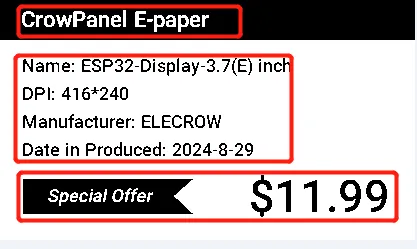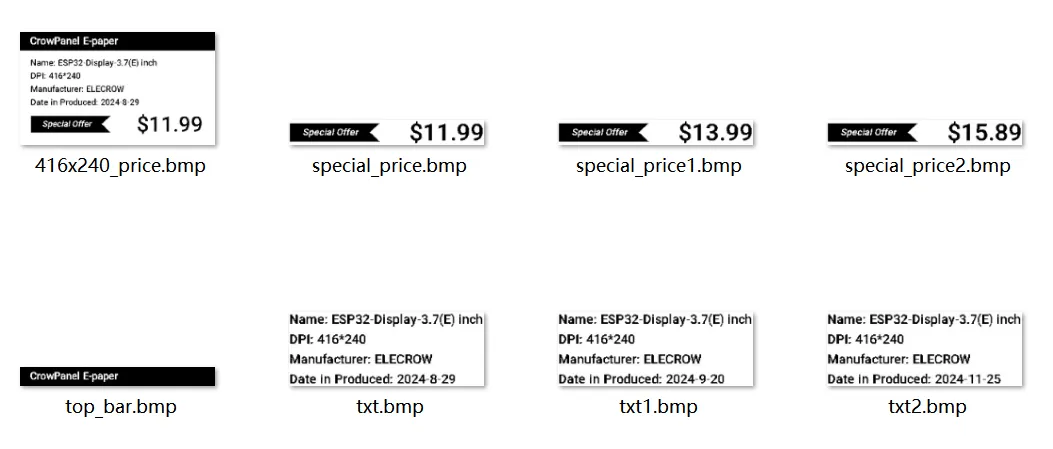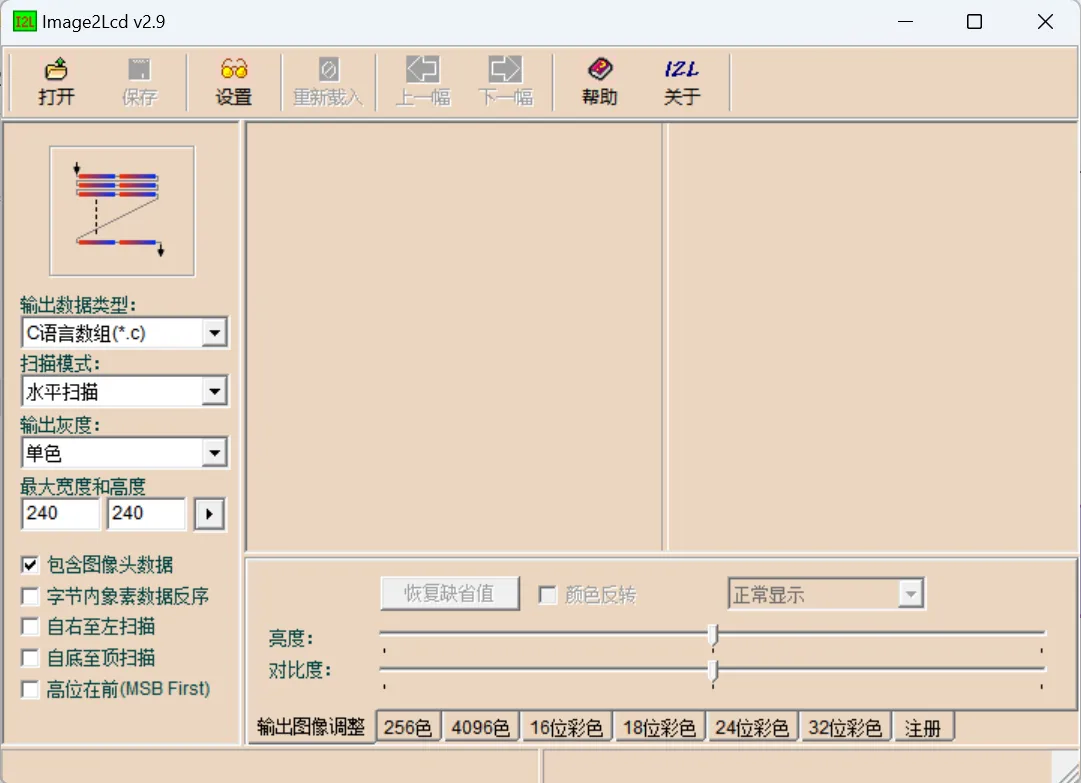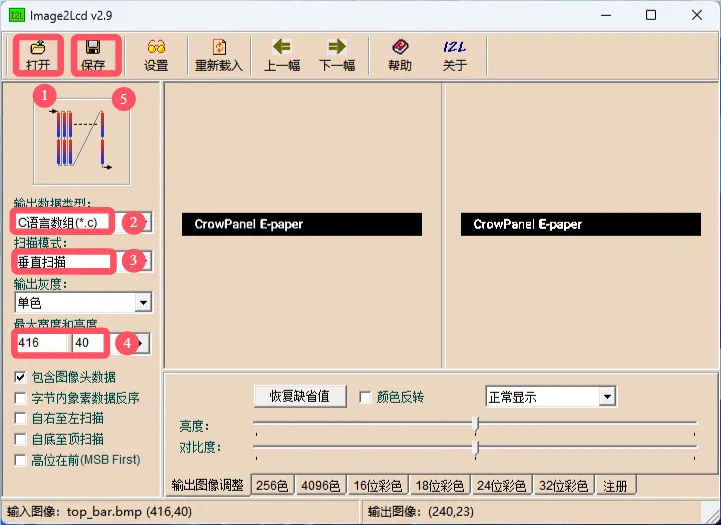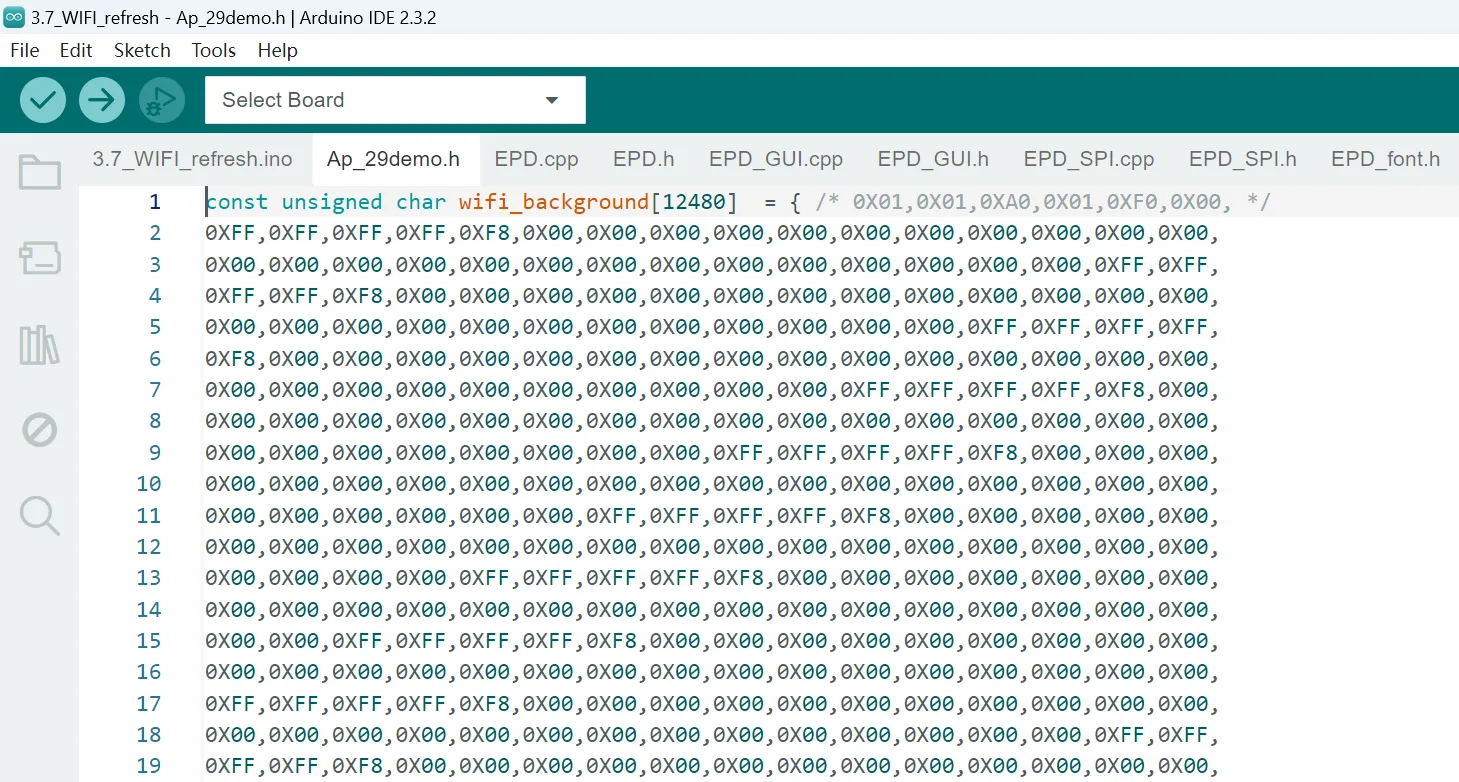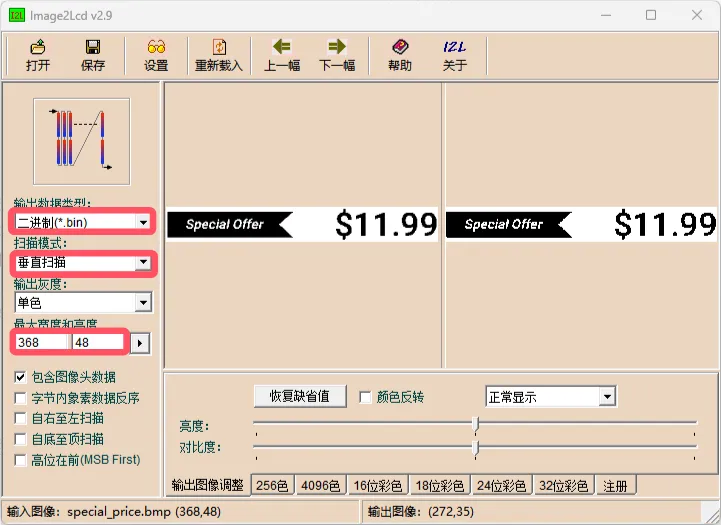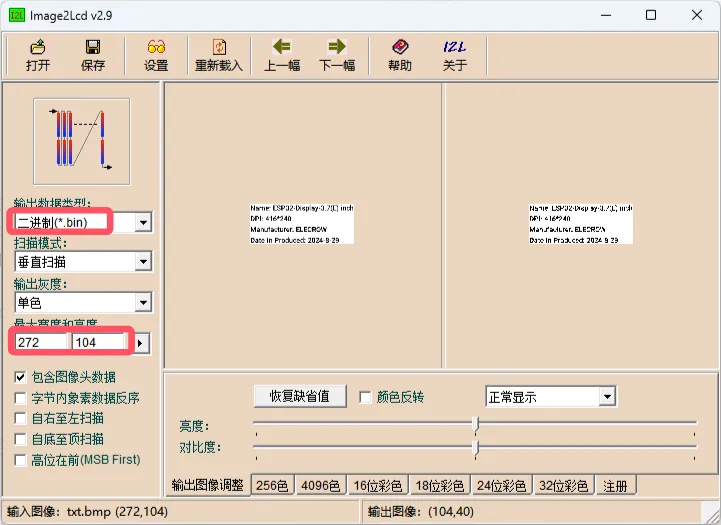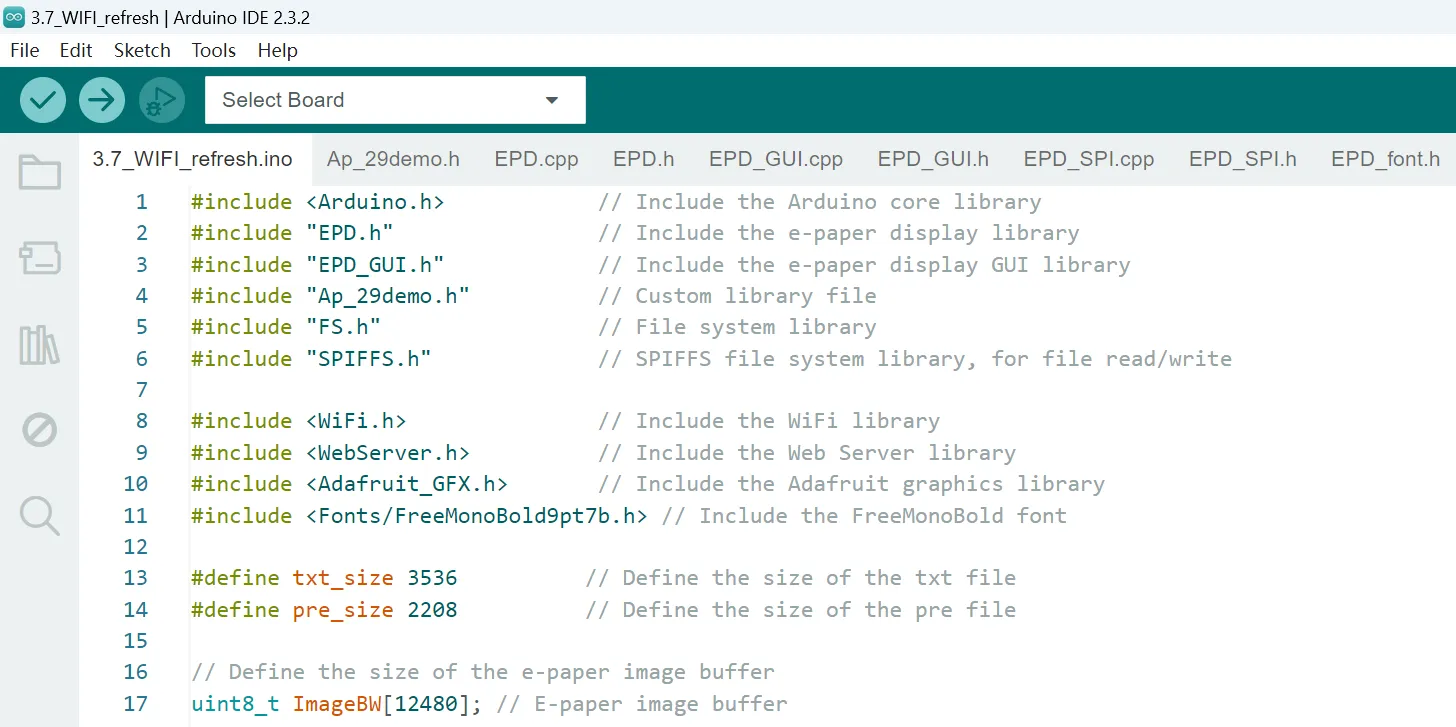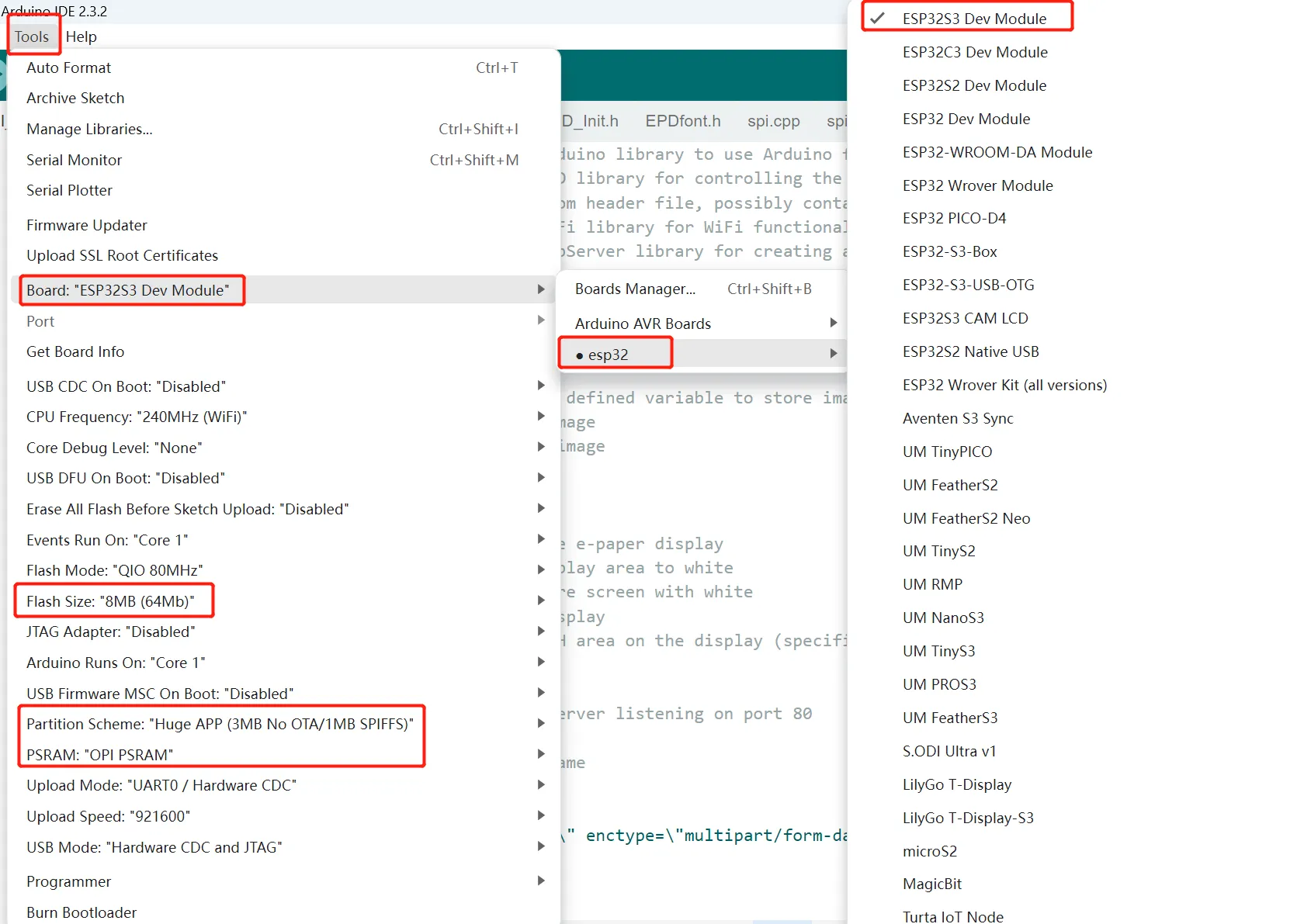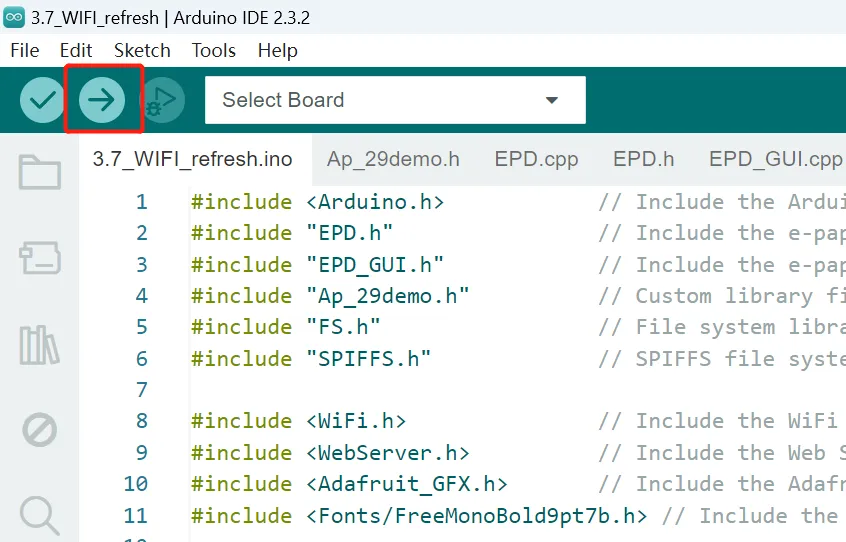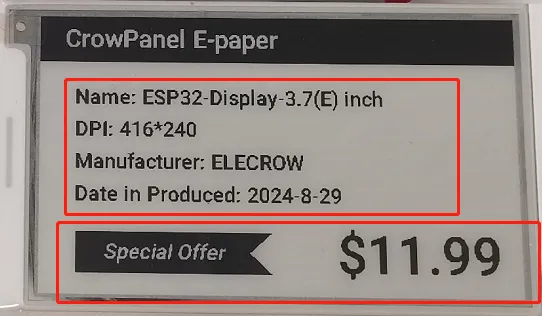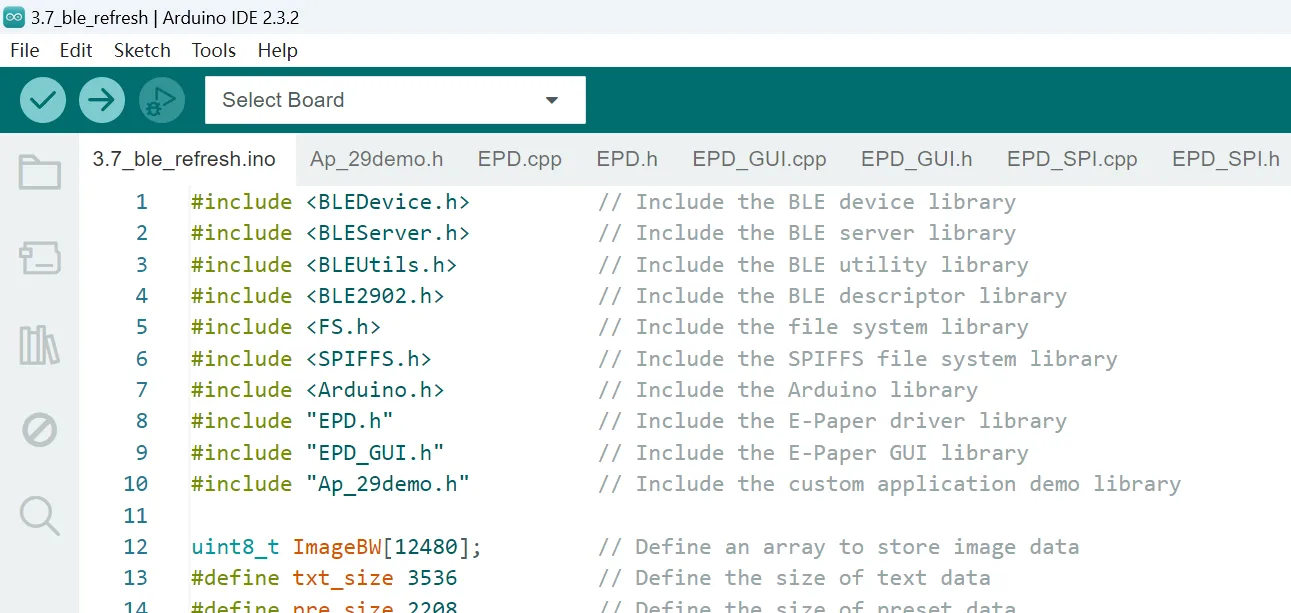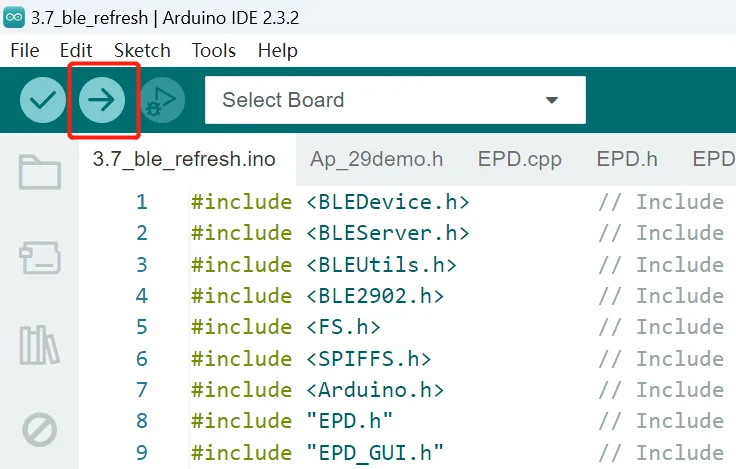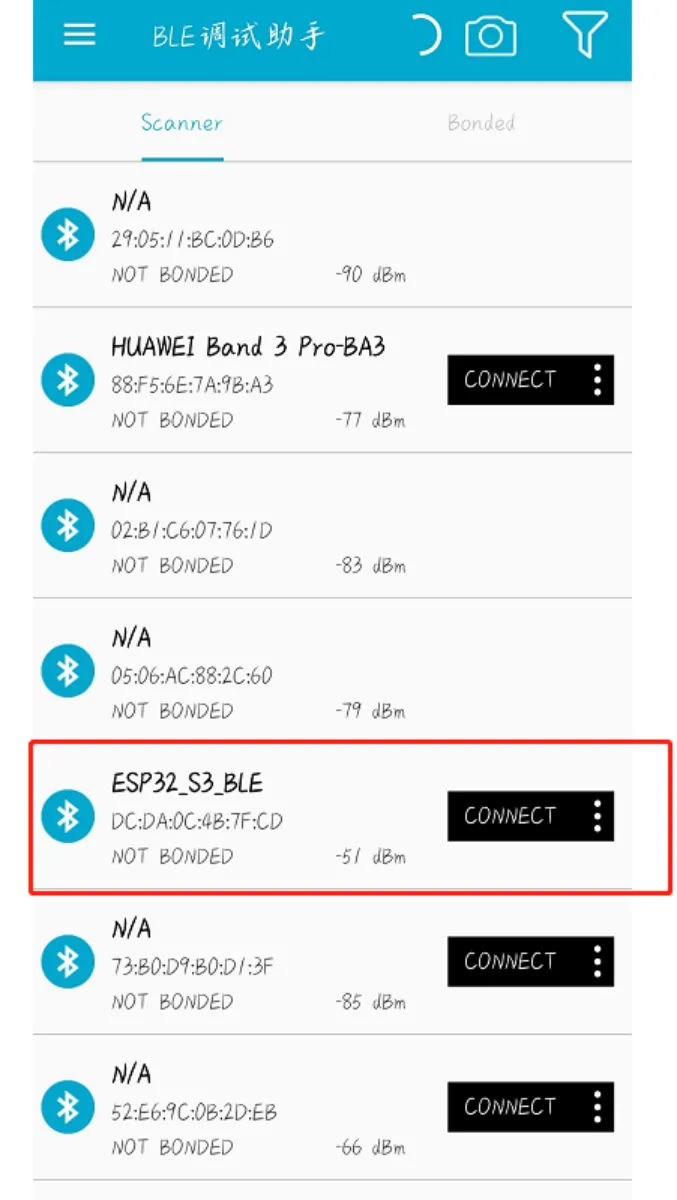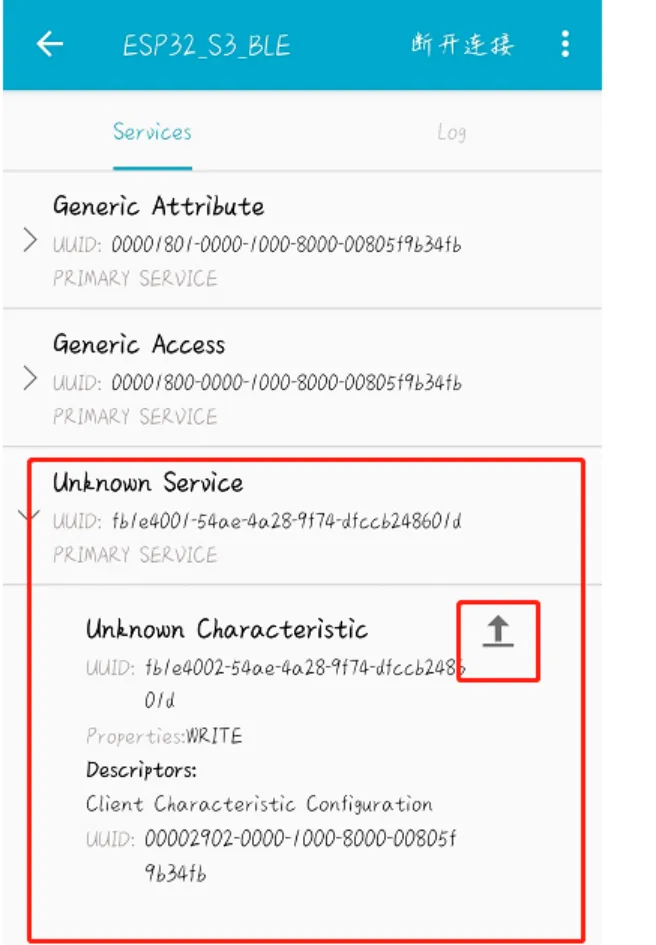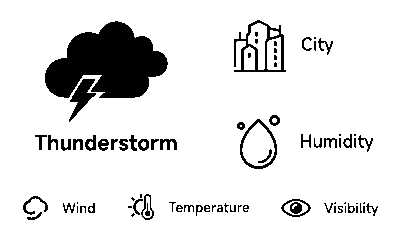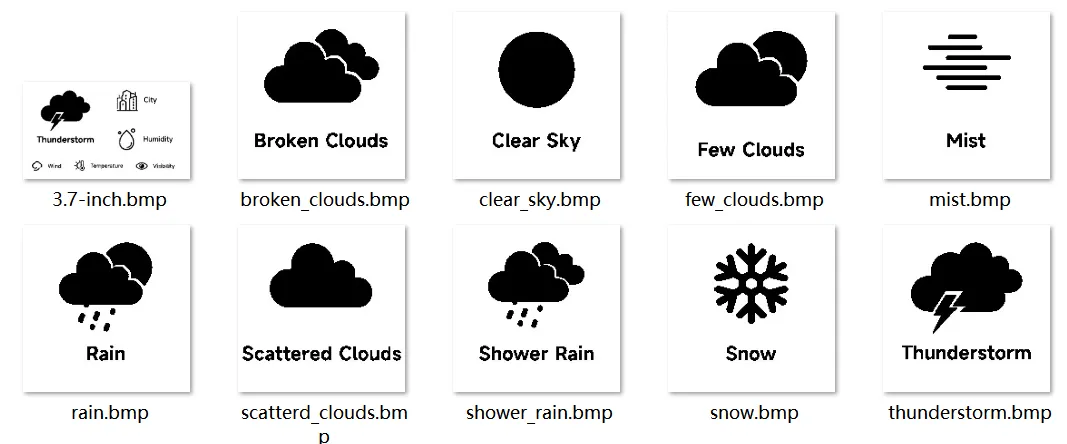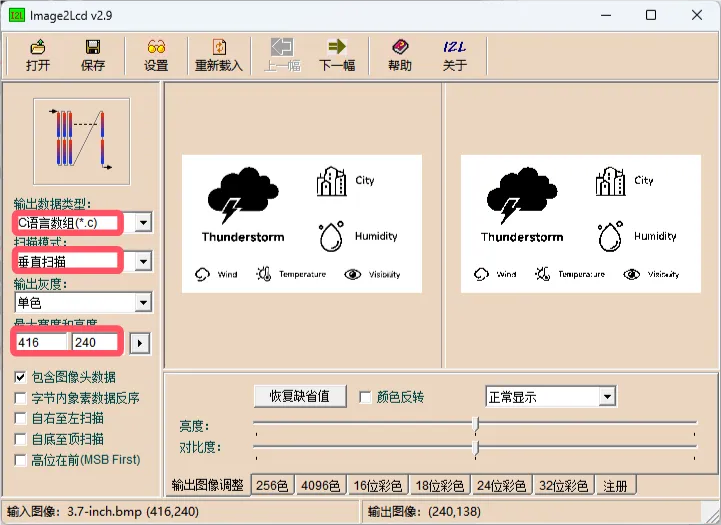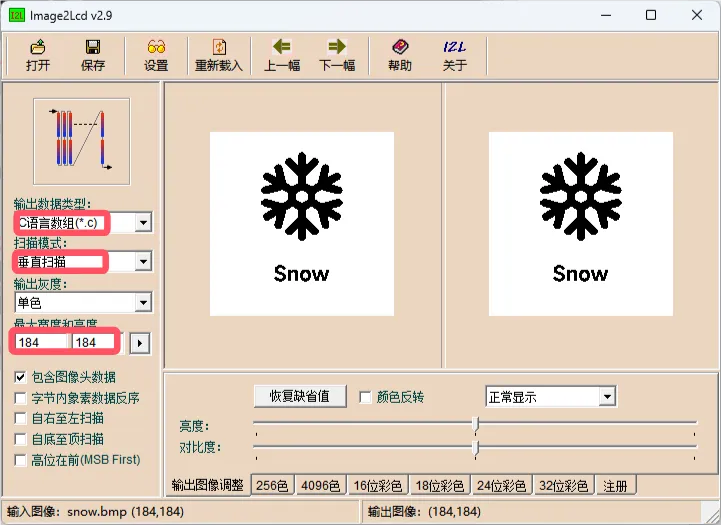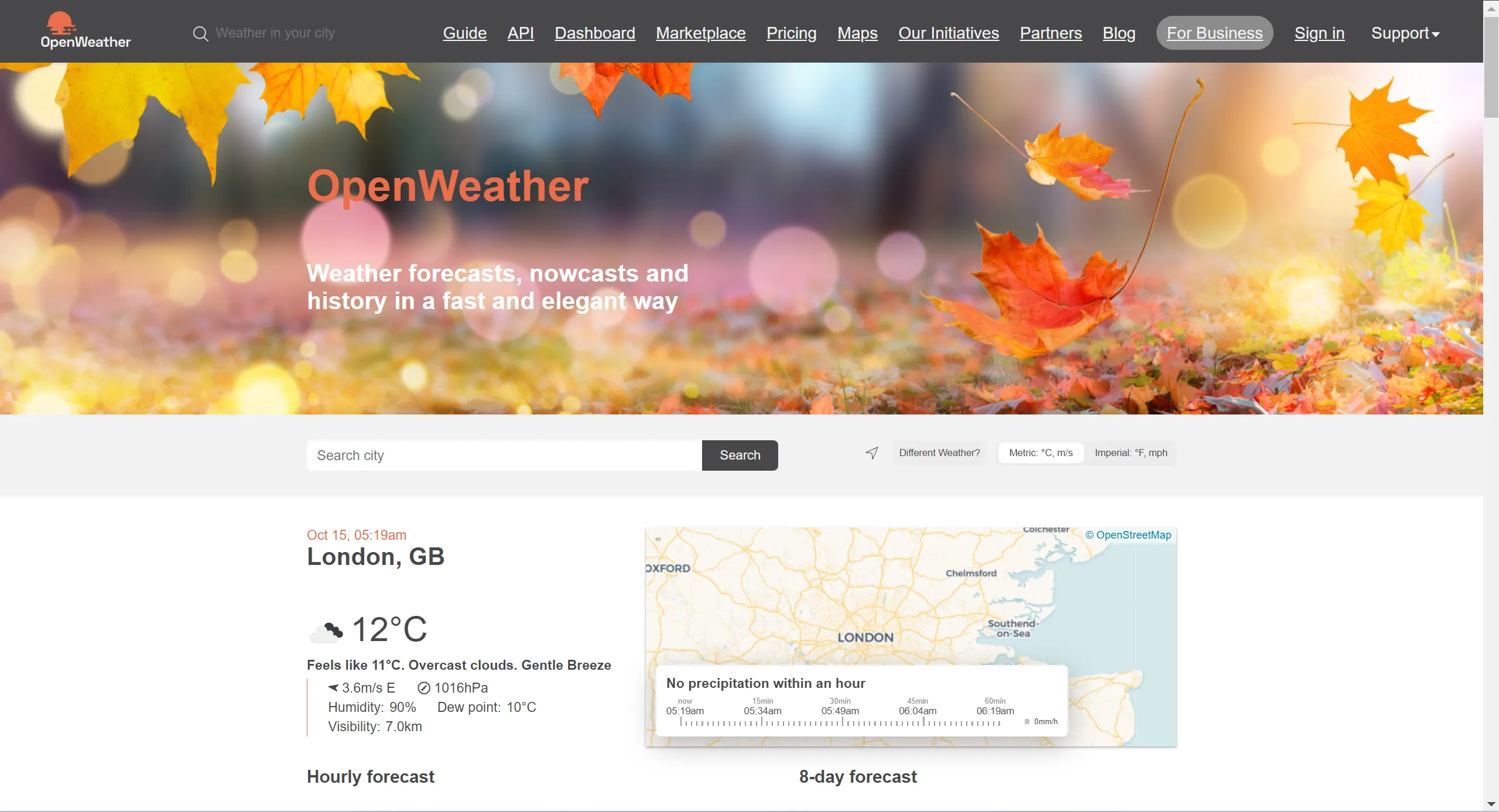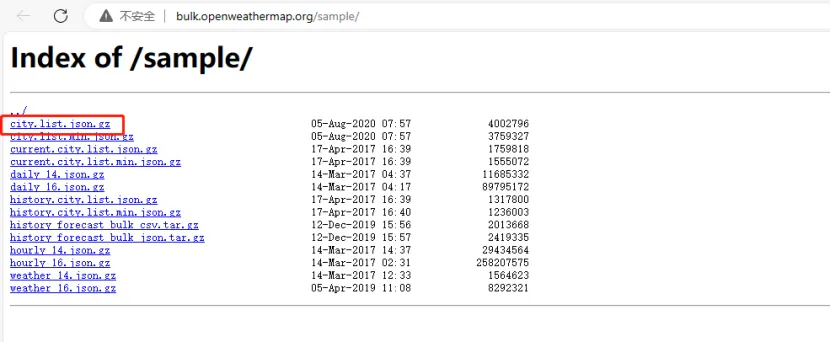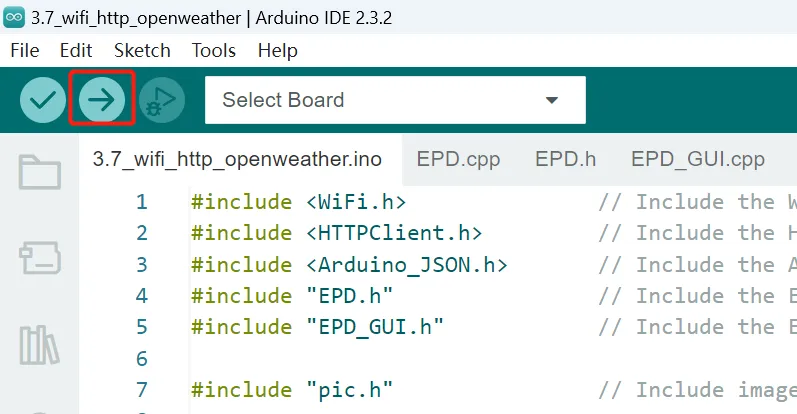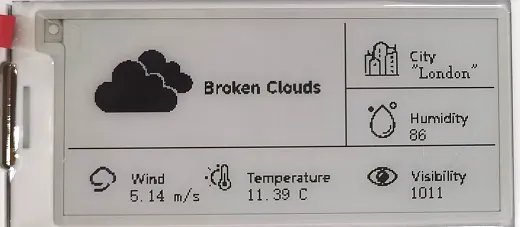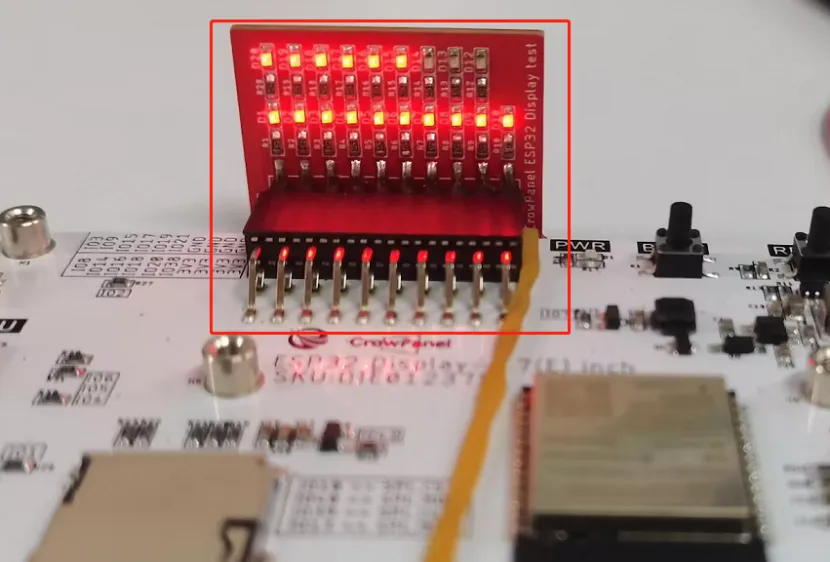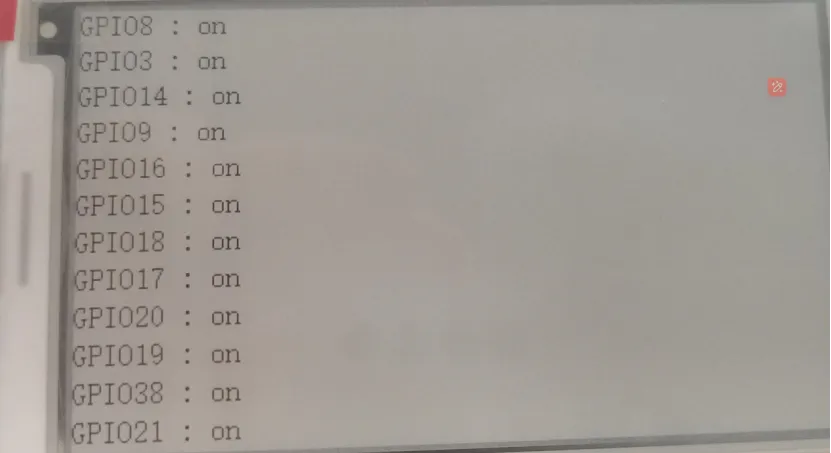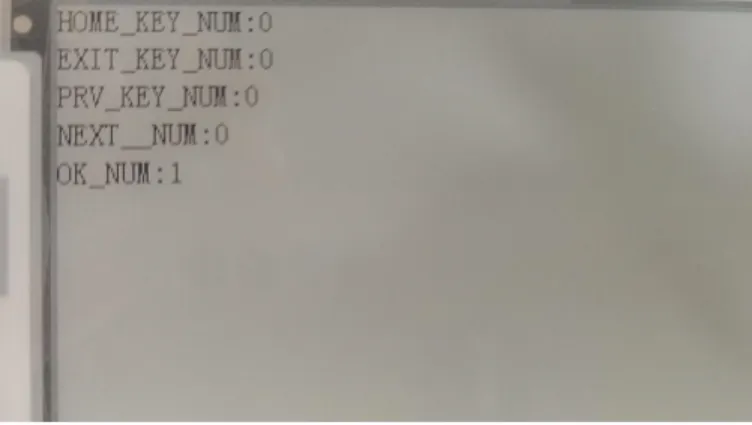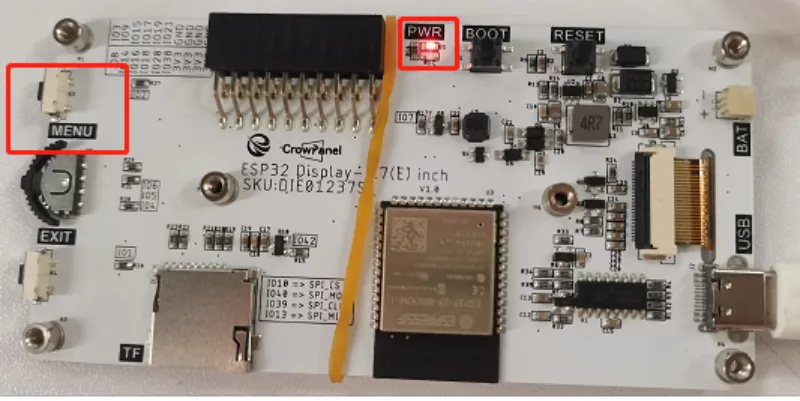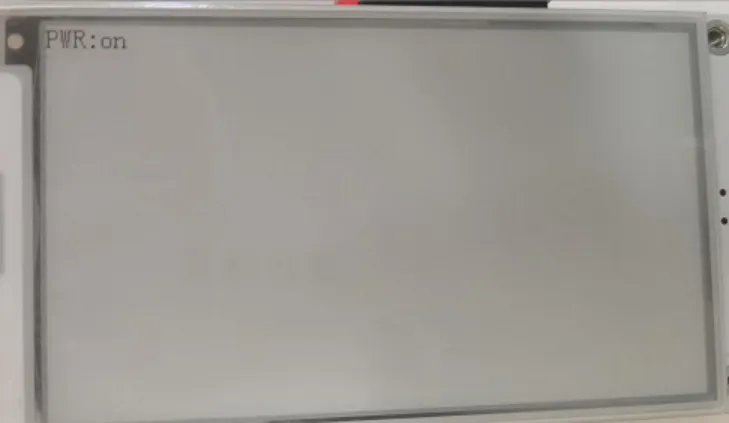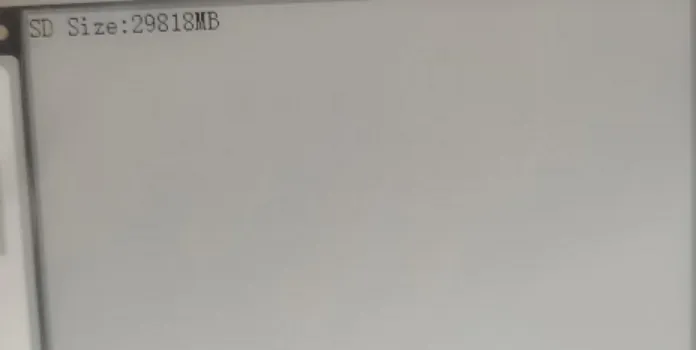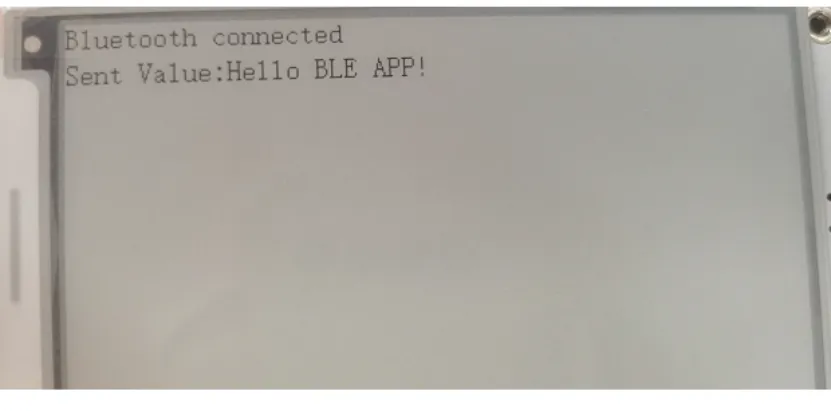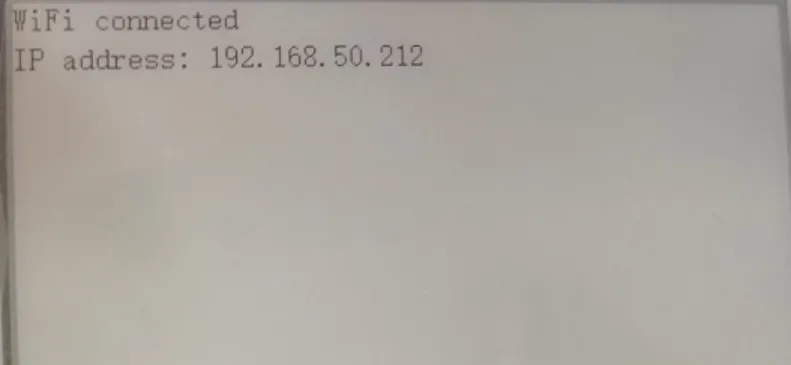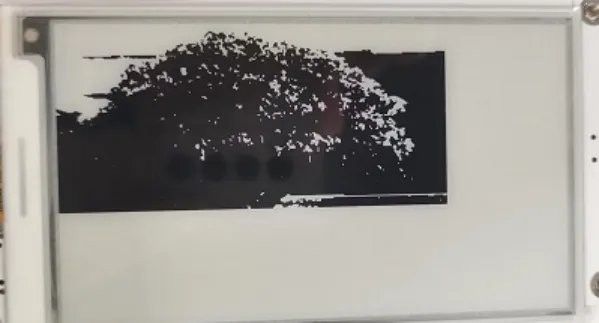CrowPanel ESP32 E-Paper 3.7-inch Arduino Tutorial¶
Overall¶
This tutorial will demonstrate how to use ESP32 E-Paper Display as a price tags and update price images through WiFi and Bluetooth. And how to obtain weather information and display it on ESP32 E-paper display. In addition, there are simple examples to illustrate how to use the various interfaces on the board.
Get Started with Arduino IDE¶
Please click the card below to learn how to install Arduino IDE, and install ESP32 board in the Arduino IDE.
Demo 1 Update Pictures Wireless¶
This demo will introduce how to wireless update a single price tag through WiFi and Bluetooth.
Update via WiFi¶
Convert the image format¶
First, let's take a look at the price tag we design in this example, which is divided into three parts(all are images). The top bar is a fixed. The description and the price is variable. The parts we need to update are the description and price.
For the fixed top bar, we can convert it to C array and put them in the code.
For the variable description and price, we need to convert them to bin file and upload them to the board through WiFi.
-
Click open and select top-bar.bmp, convert it to array format.
- Open file
- Output date type: C language array by default
- Scan mode: Vertical scan (the 2nd one)
- The biggest width and height: Consistent with the width and height of the image. Note that it must be a multiple of 8, otherwise it cannot be displayed properly
- Save and output
You can put this array in a suitable header file, and I have placed it in Ap_29demo. h here.
-
Convert the description pictures and price tag pictures to bin files. These bin files will be used to update prices over WiFi.
- Open the file
- The output type select .bin file
- The width and height should consistent with the width and height of the image. Note that it must be a multiple of 8, otherwise it cannot be displayed properly
- Save the file
Code Explanation¶
Please click  to download the code file WIFI_refresh.zip for this demo.
to download the code file WIFI_refresh.zip for this demo.
Add necessary libraries
#include <Arduino.h> // Include the Arduino core library
#include "EPD.h" // Include the e-paper display library
#include "EPD_GUI.h" // Include the e-paper display GUI library
#include "Ap_29demo.h" // Custom library file
#include "FS.h" // File system library
#include "SPIFFS.h" // SPIFFS file system library, for file read/write
#include <WiFi.h> // Include the WiFi library
#include <WebServer.h> // Include the Web Server library
#include <Adafruit_GFX.h> // Include the Adafruit graphics library
#include <Fonts/FreeMonoBold9pt7b.h> // Include the FreeMonoBold font
Define the file variable fsUploadFile Used for accessing files, txt_size and pre_size correspond to the size of the BIN file(Exported in the above steps) for the text label and price label to be transmitted. The image resolution requirement is smaller than the screen resolution and both width and height are multiples of 8.
#define txt_size 3536 // Define the size of the txt file
#define pre_size 2208 // Define the size of the pre file
Note: The size here can be defined based on the size of the images to be transmitted later, otherwise it will cause image transfer failure
UI_price() Function
Check if the file system has saved UI images, and if so, display them.
// Function to update the price interface
void UI_price() {
// txt:3536 pre:2208
EPD_FastInit(); // Fast initialize the screen
EPD_ShowPicture(0, 0, EPD_H, 40, background_top, WHITE); // Show the background image
EPD_Display(ImageBW); // Update the screen display
EPD_Update(); // Refresh the screen
EPD_DeepSleep(); // Enter deep sleep mode
// Check if the file exists and read its content
if (SPIFFS.exists("/txt.bin")) { // Check if /txt.bin file exists
File file = SPIFFS.open("/txt.bin", FILE_READ); // Open the file for reading
if (!file) {
Serial.println("Failed to open file for reading"); // If the file cannot be opened, print an error message
return;
}
// Read data from the file into the array
size_t bytesRead = file.read(txt_formerly, txt_size);
Serial.println("File content:"); // Print the file content
while (file.available()) {
Serial.write(file.read()); // Read the file content byte by byte
}
file.close(); // Close the file
EPD_FastInit(); // Fast initialize the screen
EPD_ShowPicture(30, 60, 272, 104, txt_formerly, WHITE); // Show the file content image
EPD_Display(ImageBW); // Update the screen display
EPD_Update(); // Refresh the screen
EPD_DeepSleep(); // Enter deep sleep mode
}
if (SPIFFS.exists("/pre.bin")) { // Check if /pre.bin file exists
File file = SPIFFS.open("/pre.bin", FILE_READ); // Open the file for reading
if (!file) {
Serial.println("Failed to open file for reading"); // If the file cannot be opened, print an error message
return;
}
// Read data from the file into the array
size_t bytesRead = file.read(price_formerly, pre_size);
Serial.println("File content:"); // Print the file content
while (file.available()) {
Serial.write(file.read()); // Read the file content byte by byte
}
file.close(); // Close the file
EPD_FastInit(); // Fast initialize the screen
EPD_ShowPicture(30, 180, 368, 48, price_formerly, WHITE); // Show the price image
EPD_Display(ImageBW); // Update the screen display
EPD_Update(); // Refresh the screen
EPD_DeepSleep(); // Enter deep sleep mode
}
}
okPage() Function
Receive the bin file sent and determine if it matches the pre-set file size. If it matches, store it in the file system and update the display icon.
// Handle file upload and display on the e-paper
void okPage() {
server.send(200, "text/html", HTML_OK); // Send the success page
HTTPUpload& upload = server.upload(); // Get the uploaded file data
// Note: The initial size of upload.buf is only 1436 bytes, adjust as needed
// Click ctrl + left mouse button on upload.buf to find HTTP_UPLOAD_BUFLEN in WebServer.h
// Adjust it to an appropriate size (e.g., 14360 bytes)
if (upload.status == UPLOAD_FILE_END) { // Upload completed
Serial.println("Drawing file");
Serial.println(upload.filename); // Print the filename
Serial.println(upload.totalSize); // Print the file size
// Determine the file type based on the file size
if (upload.totalSize == txt_size) // If the file size matches txt_size
filename = "txt.bin"; // Set the filename to txt.bin
else
filename = "pre.bin"; // Otherwise, set the filename to pre.bin
// Save the received file
if (!filename.startsWith("/")) filename = "/" + filename; // Ensure the filename starts with '/'
fsUploadFile = SPIFFS.open(filename, FILE_WRITE); // Open the file for writing
fsUploadFile.write(upload.buf, upload.totalSize); // Write the file content
fsUploadFile.close(); // Close the file
Serial.println("Save successful");
Serial.printf("Saved: ");
Serial.println(filename);
// Store the uploaded file data in the corresponding array
if (upload.totalSize == txt_size) {
for (int i = 0; i < txt_size; i++) {
txt_formerly[i] = upload.buf[i]; // Store the uploaded data in the txt_formerly array
}
Serial.println("txt_formerly OK");
} else {
for (int i = 0; i < pre_size; i++) {
price_formerly[i] = upload.buf[i]; // Store the uploaded data in the price_formerly array
}
Serial.println("price_formerly OK");
}
// Initialize the e-paper display and show the image
EPD_FastInit(); // Initialize the partial display mode of the E-Paper screen
EPD_ShowPicture(0, 0, EPD_H, 40, background_top, WHITE); // Show the background image
// Display the appropriate content based on the uploaded file type
if (upload.totalSize != txt_size) {
EPD_ShowPicture(30, 180, 368, 48, price_formerly, WHITE); // Show the content of the pre file
} else {
EPD_ShowPicture(30, 60, 272, 104, txt_formerly, WHITE); // Show the content of the txt file
}
EPD_Display(ImageBW); // Update the screen content
EPD_Update(); // Refresh the screen content
EPD_DeepSleep(); // Enter deep sleep mode to save power
}
}
Image Refresh Process
-
Initialization
EPD_GPIOInit(); // Initialize the screen GPIO Paint_NewImage(ImageBW, EPD_W, EPD_H, 180, WHITE); // Create a new image canvas Paint_Clear(WHITE); // Clear the canvas EPD_FastInit(); // Fast initialize the screen EPD_Display_Clear(); // Clear the screen display EPD_Update(); // Update the screen display -
Initialize to fast mode display screen
-
Select the data to refresh
-
Update the image to the screen
Upload the Code¶
-
Open the 3.7_WIFI_refresh.ino
-
Click "Tools"->"Board"->"esp32"->"ESP32S3 Dev Module", and the "Partition Scheme" select "Huge APP (3MB No OTA/1MB SPIFFS)", "PSRAM" select "OPI PSRAM".
-
Connect CorwPanel to the computer, click on "Tool" and select the corresponding "port".
-
Click "Upload" to upload the code to the board. There will be an image show on the screen.
Update the price tag with WiFi¶
-
Connect a laptop to the hotspot of the ESP32 E-PAPER display.
-
Enter the IP address 192.168.4.1 in the browser.
-
Select the bin file of the picture you need to show, then click submit.
Note: The size of the images you transfer must be consistent with the size defined in the code, otherwise it will cause image transfer failure
-
After successful transmission, the price and text will be replaced, and the data will be saved in flash.
Update via Bluetooth¶
Convert the image format¶
The same as the method in the "Update via WiFi".
Code Explanation¶
Please click  to download the code file 3.7_ble_refresh.zip for this demo.
to download the code file 3.7_ble_refresh.zip for this demo.
Add necessary libraries
#include <BLEDevice.h> // Include the BLE device library
#include <BLEServer.h> // Include the BLE server library
#include <BLEUtils.h> // Include the BLE utility library
#include <BLE2902.h> // Include the BLE descriptor library
#include <FS.h> // Include the file system library
#include <SPIFFS.h> // Include the SPIFFS file system library
#include <Arduino.h> // Include the Arduino library
#include "EPD.h" // Include the E-Paper driver library
#include "EPD_GUI.h" // Include the E-Paper GUI library
#include "Ap_29demo.h" // Include the custom application demo library
Define the file variable fsUploadFile Used for accessing files, txt_size and pre_size correspond to the size of the BIN file(Exported in the above steps) for the text label and price label to be transmitted. The image resolution requirement is smaller than the screen resolution and both width and height are multiples of 8
#define txt_size 3536 // Define the size of text data
#define pre_size 2208 // Define the size of preset data
Note: The size here can be defined based on the size of the images to be transmitted later, otherwise it will cause image transfer failure
ble_pic function
Process the bin file sent and determine if it matches the pre-set file size. If it does, store it in the file system and update the display icon.
// Process BLE received data
void ble_pic()
{
// Check if data has been received
if (dataReceived) {
// If the data buffer is not empty
if (!dataBuffer.empty()) {
size_t bufferSize = dataBuffer.size(); // Get the size of the data buffer
Serial.println(bufferSize); // Print the size of the data buffer to the serial monitor
// Determine the filename based on the size of the data buffer
if (dataBuffer.size() == txt_size) // If the data size equals txt_size
filename = "txt.bin"; // Set the filename to txt.bin
else
filename = "pre.bin"; // Otherwise, set the filename to pre.bin
// Ensure the filename starts with a slash
if (!filename.startsWith("/")) filename = "/" + filename;
// Open the file for writing
fsUploadFile = SPIFFS.open(filename, FILE_WRITE);
fsUploadFile.write(dataBuffer.data(), dataBuffer.size()); // Write the data to the file
fsUploadFile.close(); // Close the file
Serial.println("Save successful"); // Print a success message
Serial.printf("Saved: ");
Serial.println(filename); // Print the saved filename
// Copy the data to different arrays based on the data size
if (bufferSize == txt_size)
{
for (int i = 0; i < txt_size; i++) {
txt_formerly[i] = dataBuffer[i]; // Copy the data to the txt_formerly array
}
Serial.println("txt_formerly OK"); // Print a success message for processing the txt_formerly array
} else
{
for (int i = 0; i < pre_size; i++) {
price_formerly[i] = dataBuffer[i]; // Copy the data to the price_formerly array
}
Serial.println("price_formerly OK"); // Print a success message for processing the price_formerly array
}
EPD_FastInit(); // Initialize the partial display mode of the E-Paper screen
EPD_ShowPicture(0, 0, EPD_H, 40, background_top, WHITE); // Display the background image
// Display different images on the screen based on the data size
if (bufferSize != txt_size)
{
EPD_ShowPicture(30, 180, 368, 48, price_formerly, WHITE); // Display the price image
} else
{
EPD_ShowPicture(30, 60, 272, 104, txt_formerly, WHITE); // Display the text image
}
EPD_Display(ImageBW); // Update the screen content
EPD_Update(); // Refresh the screen content
EPD_DeepSleep(); // Enter deep sleep mode to save power
// Clear the buffer after writing the data
dataBuffer.clear();
totalReceivedBytes = 0; // Reset the total number of bytes received
}
// Reset the flag after processing the data
dataReceived = false;
}
}
class MyCallbacks : public BLECharacteristicCallbacks
Receive the data sent and integrate it together. Receiving the "OK" character indicates that the transmission is complete.
// BLE characteristic callback class
class MyCallbacks : public BLECharacteristicCallbacks {
void onWrite(BLECharacteristic *pCharacteristic) {
std::string value = pCharacteristic->getValue(); // Get the written data
if (value.length() > 0) { // If the length of the received data is greater than 0
Serial.printf("."); // Print a dot in the serial monitor to indicate data reception
if (value == "OK") { // If the received data is "OK"
dataReceived = true; // Set the data received flag to true
return; // Exit the function
}
size_t len = value.length(); // Get the data length
if (len > 0) { // If the data length is greater than 0
// Append the received data to the buffer
dataBuffer.insert(dataBuffer.end(), value.begin(), value.end());
totalReceivedBytes += len; // Update the total number of bytes received
}
}
}
};
UI_price
Check if the file system has saved UI images, and if so, display them.
// Display the price interface
void UI_price()
{
// Predefined: txt size is 3536, pre size is 2208
EPD_FastInit(); // Initialize the fast mode of the E-Paper screen
EPD_ShowPicture(0, 0, EPD_H, 40, background_top, WHITE); // Display the background image
EPD_Display(ImageBW); // Update the screen content
EPD_Update(); // Refresh the screen content
EPD_DeepSleep(); // Enter deep sleep mode to save power
// If the txt.bin file exists, read and display it
if (SPIFFS.exists("/txt.bin")) {
File file = SPIFFS.open("/txt.bin", FILE_READ); // Open the txt.bin file for reading
if (!file) {
Serial.println("Failed to open file for reading"); // If the file cannot be opened, print an error message
return;
}
// Read data from the file into the array
size_t bytesRead = file.read(txt_formerly, txt_size);
Serial.println("File content:");
while (file.available()) {
Serial.write(file.read()); // Print the file content to the serial monitor
}
file.close(); // Close the file
EPD_FastInit(); // Initialize the fast mode of the E-Paper screen
EPD_ShowPicture(30, 60, 272, 104, txt_formerly, WHITE); // Display the text image on the screen
EPD_Display(ImageBW); // Update the screen content
EPD_Update(); // Refresh the screen content
EPD_DeepSleep(); // Enter deep sleep mode to save power
}
// If the pre.bin file exists, read and display it
if (SPIFFS.exists("/pre.bin")) {
File file = SPIFFS.open("/pre.bin", FILE_READ); // Open the pre.bin file for reading
if (!file) {
Serial.println("Failed to open file for reading"); // If the file cannot be opened, print an error message
return;
}
// Read data from the file into the array
size_t bytesRead = file.read(price_formerly, pre_size);
Serial.println("File content:");
while (file.available()) {
Serial.write(file.read()); // Print the file content to the serial monitor
}
file.close(); // Close the file
EPD_FastInit(); // Initialize the fast mode of the E-Paper screen
EPD_ShowPicture(30, 180, 368, 48, price_formerly, WHITE); // Display the price image on the screen
EPD_Display(ImageBW); // Update the screen content
EPD_Update(); // Refresh the screen content
EPD_DeepSleep(); // Enter deep sleep mode to save power
}
}
Image Refresh Process
-
Initialization
EPD_GPIOInit(); // Initialize the screen GPIO Paint_NewImage(ImageBW, EPD_W, EPD_H, 180, WHITE); // Create a new image canvas Paint_Clear(WHITE); // Clear the canvas EPD_FastInit(); // Fast initialize the screen EPD_Display_Clear(); // Clear the screen display EPD_Update(); // Update the screen display -
Initialize to fast mode display screen
-
Select the data to refresh
-
Update the image to the screen
Upload the Code¶
-
Double click the 3.7_ble_refresh.ino.
-
Click "Tools"->"Board"->"esp32"->"ESP32S3 Dev Module", and the "Partition Scheme" select "Huge APP (3MB No OTA/1MB SPIFFS)", "PSRAM" select "OPI PSRAM".
-
Connect CorwPanel to the computer, click on "Tool" and select the corresponding "port".
-
Click "Upload" to upload the code to the board. There will be an image show on the screen.
Update the images via bluetooth¶
-
Download a BLE debugging assistant to your phone, and connect it your phone to the screen device BLE.
-
Upload the bin file(Save the bin file to your phone in advance).
Note: The size of the images you transfer must be consistent with the size defined in the code, otherwise it will cause image transfer failure
-
After successful transmission, the price and text will be replaced, and the data will be saved in flash.
Demo 2 Weather Station¶
Obtain weather information through OpenWeather and display the information on the CrowPanel.
Convert the image format¶
First, let's take a look at the weather information panel we design in this example, which is divided into 6 parts(all are images).
- weather icon
- city
- humidity
- wind
- temperature
-
visibility
-
Only the weather icon is variable, while the other icons are fixed. Therefore, we can use "3.7-inch.bmp" as the background image, while the weather icon varies depending on the weather conditions.
Next, we need to convert these images into a C array format and include it in the code
-
Click open and select the images, convert them to array format.
- Open file
- Output date type: C language array by default
- The biggest width and height: Consistent with the width and height of the image. Note that it must be a multiple of 8, otherwise it cannot be displayed properly
- Save and output
You can put this array in a suitable header file, and I have placed it in pic. h here.
Register an OpenWeather account¶
-
Enter https://openweathermap.org/ and click "Sing in" to register an OpenWeather account.
-
Log in your account.
-
Click your user name -> "My API Keys" to find your API key.
Code Explanation¶
Please click  to download the code file 3.7_wifi_http_openweather.zip for this demo.
to download the code file 3.7_wifi_http_openweather.zip for this demo.
Add libraries¶
#include <WiFi.h> // Include the WiFi library for wireless network functionality
#include <HTTPClient.h> // Include the HTTPClient library for handling HTTP requests
#include <Arduino_JSON.h> // Include the Arduino_JSON library for JSON data processing
#include "EPD.h" // Include the EPD library for controlling the electronic ink screen (E-Paper Display)
#include "EPD_GUI.h" // Include the EPD_GUI library for graphical user interface (GUI) operations
#include "pic.h" // Include image resources
Modify your information¶
const char* ssid = " "; // Enter your ssid
const char* password = " "; // Enter your WiFi password
// OpenWeatherMap API key
String openWeatherMapApiKey = "You-API"; //Enter your API key
// For example: String openWeatherMapApiKey = "bd939aa3d23ff33d3c8f5dd1dd435";
// Replace with city and country code you're in
String city = "London"; // City Name
String countryCode = "2643743"; // Country Code
Country Code
You can find the country code at: http://bulk.openweathermap.org/sample/
Function Explanation¶
js_analysis
This function is mainly used to parse the received JSON data, process these data separately, and save them in variables.
void js_analysis()
{
// Check if WiFi is connected
if (WiFi.status() == WL_CONNECTED) {
// Construct the request path including city, country code, API key, and unit parameters
String serverPath = "http://api.openweathermap.org/data/2.5/weather?q=" + city + "," + countryCode + "&APPID=" + openWeatherMapApiKey + "&units=metric";
// Loop until data is successfully retrieved (HTTP response code is 200)
while (httpResponseCode != 200)
{
// Send an HTTP GET request and get the returned JSON data
jsonBuffer = httpGETRequest(serverPath.c_str());
Serial.println(jsonBuffer); // Print the retrieved JSON data
myObject = JSON.parse(jsonBuffer); // Parse the JSON data
// Check if JSON parsing was successful
if (JSON.typeof(myObject) == "undefined") {
Serial.println("Parsing input failed!"); // Print an error message if parsing fails
return; // Exit the function
}
delay(2000); // Wait 2 seconds before retrying
}
// Extract the required data from the JSON object
weather = JSON.stringify(myObject["weather"][0]["main"]); // Weather condition
temperature = JSON.stringify(myObject["main"]["temp"]); // Temperature
humidity = JSON.stringify(myObject["main"]["humidity"]); // Humidity
sea_level = JSON.stringify(myObject["main"]["sea_level"]); // Sea level pressure
wind_speed = JSON.stringify(myObject["wind"]["speed"]); // Wind speed
city_js = JSON.stringify(myObject["name"]); // City name
// Print the extracted data
Serial.print("String weather: ");
Serial.println(weather);
Serial.print("String Temperature: ");
Serial.println(temperature);
Serial.print("String humidity: ");
Serial.println(humidity);
Serial.print("String sea_level: ");
Serial.println(sea_level);
Serial.print("String wind_speed: ");
Serial.println(wind_speed);
Serial.print("String city_js: ");
Serial.println(city_js);
// Set the weather flag based on the weather condition
if (weather.indexOf("clouds") != -1 || weather.indexOf("Clouds") != -1) {
weather_flag = 1; // Cloudy
} else if (weather.indexOf("clear sky") != -1 || weather.indexOf("Clear sky") != -1) {
weather_flag = 3; // Sunny
} else if (weather.indexOf("rain") != -1 || weather.indexOf("Rain") != -1) {
weather_flag = 5; // Rainy
} else if (weather.indexOf("thunderstorm") != -1 || weather.indexOf("Thunderstorm") != -1) {
weather_flag = 2; // Thunderstorm
} else if (weather.indexOf("snow") != -1 || weather.indexOf("Snow") != -1) {
weather_flag = 4; // Snowy
} else if (weather.indexOf("mist") != -1 || weather.indexOf("Mist") != -1) {
weather_flag = 0; // Foggy
}
}
else {
Serial.println("WiFi Disconnected"); // Print an error message if WiFi is disconnected
}
}
// HTTP GET request function
String httpGETRequest(const char* serverName) {
WiFiClient client;
HTTPClient http;
// Initialize the HTTP client and specify the server address for the request
http.begin(client, serverName);
// Send the HTTP GET request
httpResponseCode = http.GET();
String payload = "{}"; // Default to an empty JSON object
// Check the HTTP response code
if (httpResponseCode > 0) {
Serial.print("HTTP Response code: ");
Serial.println(httpResponseCode); // Print the response code
payload = http.getString(); // Get the response data
}
else {
Serial.print("Error code: ");
Serial.println(httpResponseCode); // Print the error code
}
// Release resources
http.end();
return payload; // Return the response data
}
UI_weather_forecast
Display the processed data saved in the variable on the screen.
// Display the weather forecast interface
void UI_weather_forecast() {
char buffer[40]; // Character array to store information
EPD_GPIOInit(); // Initialize screen GPIO
Paint_NewImage(ImageBW, EPD_W, EPD_H, 180, WHITE); // Create a new image canvas
Paint_Clear(WHITE); // Clear the canvas
EPD_FastInit(); // Fast initialize the screen
EPD_Display_Clear(); // Clear the screen display
EPD_Update(); // Update the screen display
EPD_FastInit(); // Fast initialize the screen
// Display background image and weather icon
EPD_ShowPicture(0, 0, 416, 240, pic, WHITE);
EPD_ShowPicture(14, 2, 184, 184, Weather_Num[weather_flag], WHITE);
// Draw partition lines
EPD_DrawLine(0, 180, 416, 180, BLACK); // Draw horizontal line
EPD_DrawLine(215, 0, 215, 180, BLACK); // Draw vertical line
EPD_DrawLine(215, 94, 416, 94, BLACK); // Draw horizontal line
// Display city information
memset(buffer, 0, sizeof(buffer));
snprintf(buffer, sizeof(buffer), "%s ", city_js); // Format city information as a string
EPD_ShowString(301, 51, buffer, 16, BLACK); // Display city name
// Display temperature
memset(buffer, 0, sizeof(buffer));
snprintf(buffer, sizeof(buffer), "%s C", temperature); // Format temperature as a string
EPD_ShowString(168, 217, buffer, 16, BLACK); // Display temperature
// Display humidity
memset(buffer, 0, sizeof(buffer));
snprintf(buffer, sizeof(buffer), "%s ", humidity); // Format humidity as a string
EPD_ShowString(301, 148, buffer, 16, BLACK); // Display humidity
// Display wind speed
memset(buffer, 0, sizeof(buffer));
snprintf(buffer, sizeof(buffer), "%s m/s", wind_speed); // Format wind speed as a string
EPD_ShowString(62, 217, buffer, 16, BLACK); // Display wind speed
// Display sea level pressure
memset(buffer, 0, sizeof(buffer));
snprintf(buffer, sizeof(buffer), "%s ", sea_level); // Format sea level pressure as a string
EPD_ShowString(324, 217, buffer, 16, BLACK); // Display sea level pressure
// Update the e-ink display content
EPD_Display(ImageBW); // Refresh the screen display
EPD_Update(); // Refresh the screen
EPD_DeepSleep(); // Enter deep sleep mode
}
Upload the Code¶
-
Double click the 3.7_wifi_http_openweather.ino.
-
Click "Tools"->"Board"->"esp32"->"ESP32S3 Dev Module", and the "Partition Scheme" select "Huge APP (3MB No OTA/1MB SPIFFS)", "PSRAM" select "OPI PSRAM".
-
Connect CorwPanel to the computer, click on "Tool" and select the corresponding "port".
-
Click "Upload" to upload the code to the board. There will be an image show on the screen.
-
After downloading, the weather information for the city you have selected will be displayed on CrowPanel.
Examples for the CrowPanel Interfaces¶
Please click  to download the code file for the examples.
to download the code file for the examples.
Example 1 Control the GPIO¶
-
Open the GPIO.ino.
-
Connect the LED to the GPIO pins.
-
Upload the code to the CrowPanel. The LEDs will turn on, and the status of the GPIO will show on the screen.
Example 2 Count the times of pressing the keys¶
Example 3 Control PWR LED with menu Key¶
-
Open the PWR.ino
-
Upload the code to the CrowPanel.
-
Press the menu key and the PWR LED will turn on/off.
Example 4 Initialize SD card¶
-
Open TF.ino
-
Insert the TF card to the card slot.
-
Upload the code to the CrowPanel.
-
The size of the TF card will show on the screen.
Example 5 Connect Bluetooth¶
-
Open BLE.ino
-
Upload the code to the CrowPanel.
-
After the blutooth is connected, the screen will show:
Example 6 Connect WiFi¶
-
Open wifi.ino
-
Modify your ssid and password
-
Upload the code to the CrowPanel.
-
After the WiFi is connected, the screen will show:
Example 7 Refresh image¶
This example will demonstrate two scenarios: refreshing full screen images and non full screen images.
- Full screen image: The resolution of the image is the same as the screen
- Non full screen image: The image resolution is lower than the screen resolution


